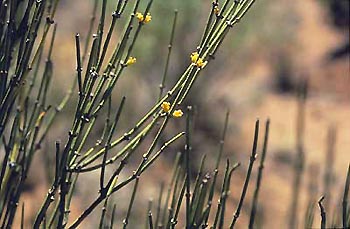Green Ephedra

Common Name(s):
Green Ephedra
Mormon Tea
Joint-fir
Scientific Name:
Ephedra viridis Coville
Scientific Name Synonyms:
None known
Symbol:
EPVI
Description:
Life Span: Perennial
Origin: Native
Season: Evergreen
Growth Characteristics: An erect shrub, growing anywhere from 8 inches to 5 feet tall. It reproduces by seed and by sprouting from the roots and woody crown.
Flowers/Inflorescence: Green ephedra is dioecious. The cones are in pairs at the stem joints.
Fruits/Seeds: Produces nut-like seeds partly or entirely enclosed in large bracts that form a cone structure.
Leaves: Opposite on the stem joints and consist of small, papery scales.
Stems: Green ephedra has numerous parallel stems that point upward resembling a broom, with branchlets clustered around nodes. Stems are generally less than 0.12 inch in diameter and are bright green, with thicker growth developing gray, shreddy bark. The jointed branches have small, scale-like, inconspicuous leaves growing opposite on the stem joints.
Ecological Adaptions:
Green ephedra is found on dry, rocky, open sites in valleys and washes, and on slopes, alluvial fans, mesas, and foothills. It is typically found at elevations ranging from 3,000 to 7,500 feet, though it has been reported at elevations up to 10,000 feet. Average precipitation on sites supporting green ephedra ranges from 6 to 15 inches. It is drought resistant and winter hardy.
Soils: Grows primarily on sandy, gravelly or rocky, well-drained, undeveloped soils. Green ephedra grows well on shallow, medium or deep soils and is tolerant of calcareous, weakly saline, moderately alkaline, and slightly sodic soils. It is intolerant of wet, poorly drained sites.
Associated Species: Big sagebrush, Nevada jointfir, galleta grass, sand dropseed, and Utah juniper.
Uses and Management:
Green ephedra is an important browse species for big game. It is not utilized by domestic livestock. It is heavily browsed by big game on winter range but only moderately or lightly browsed during other seasons. Green ephedra stems and twigs are nearly all within reach of grazing animals, and can serve as winter forage because they extend above the snow.
Green ephedra is highly toxic to both domestic sheep and cows during gestation, even at low doses. It causes ruminal impaction, diarrhea, vomiting, fecal mucus, anorexia, and in some cases death.
The stems of green ephedra were traditionally brewed by Native Americans to make a nonmedicinal beverage as well as a medicinal tea considered to be a remedy for a backache. Native Americans also made flour and a coffeelike beverage from the seeds. Ephedra species provided Native Americans with good charcoal for tatooing. Green ephedra can be used for xeriscaping projects, and has been widely used as a landscape species for roadsides, recreational sites and mine dumps. It is valuable for its vivid green color in an often dull gray sagebrush environment.

